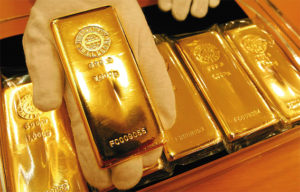 Gold fell on Friday and capped the biggest weekly decline in more than two months after protocols from FOMCs October meeting showed earlier in the week that policy makers felt overall comfortable with trimming Feds monthly bond purchases in the upcoming months, provided it warranted sustainable economic growth. Strong U.S. economic data also fueled speculations for an earlier-than-expected taper, offsetting previous comments by Fed Chairman Ben Bernanke and his probable successor Janet Yellen, who called for sustained accommodative monetary policy in the near future. Silver, platinum and palladium tracked golds downward momentum.
Gold fell on Friday and capped the biggest weekly decline in more than two months after protocols from FOMCs October meeting showed earlier in the week that policy makers felt overall comfortable with trimming Feds monthly bond purchases in the upcoming months, provided it warranted sustainable economic growth. Strong U.S. economic data also fueled speculations for an earlier-than-expected taper, offsetting previous comments by Fed Chairman Ben Bernanke and his probable successor Janet Yellen, who called for sustained accommodative monetary policy in the near future. Silver, platinum and palladium tracked golds downward momentum.
On the Comex division of the New York Mercantile Exchange, gold futures for settlement in December were mostly unchanged on Friday and settled at $1 243.00 per troy ounce after swinging between days high and low of $1 248.20 and $1 240.50 an ounce. The precious metal plunged to a 4-1/2-month low of $1 235.90 an ounce on Thursday and settled the week 3.6% lower, the weakest weekly performance in more than two months.
Gold plunged after minutes of FOMC’s October meeting revealed on Wednesday the Federal Reserve might begin trimming its quantitative easing program “in the coming months”, if the economic recovery moves in the desired direction. Fed minutes showed that policy makers “generally expected that the data would prove consistent with the committee’s outlook for ongoing improvement in labor market conditions and would thus warrant trimming the pace of purchases in coming months.”
The precious metal was further pressured after the Commerce Department reported that U.S. retail sales jumped by the most since July last month, indicating the 16-day government shutdown had minimal-to-no effect on the economy. Retail sales rose by 0.4% in October, exceeding the median estimate of 86 analysts surveyed by Bloomberg for a minor 0.1% advance. September’s reading received an upward revision to 0.0% from initially estimated at -0.1%.
Meanwhile, core retail sales, which exclude the volatile automobile market, jumped by 0.2% last month after September’s reading was revised down to 0.3% from initially calculated at 0.4%. Core retail sales correspond closely with the consumer spending component of gross domestic product (GDP). Their jump was largely based on increased demand for clothing, electronics, furniture and sporting goods.
On Thursday, the Department of Labor reported that the number of people who filed for unemployment assistance in the week ended November 16 decreased by 21 000 to reach 323 000, the lowest number since September. Expectations pointed that the number of claims will fall less, to 335 000. Last week contained a national holiday, as during such days the number of submitted claims is lower than usual. The average number of claims during the past four weeks, an indicator considered as lacking seasonal effects, dropped by 6 750 to 338 500.
Also fanning negative sentiment for golds demand prospects, the Labor Department reported on Wednesday that U.S. consumer inflation generally met analysts’ expectations and remained well below Fed’s official target of 2%, limiting demand for the precious metal as a hedge against rising prices.
The consumer price index (CPI) dropped by 0.1% in October as prices of energy, new cars and clothing fell, confounding expectations for a 0.1% increase and underperforming the preceding month’s 0.2% jump. Year-on-year, consumer inflation matched projections and rose by 1.0%, the slowest advance since October 2009, trailing September’s 1.2% gain.
Core consumer prices, which exclude the more volatile food and energy costs, met expectations and inched up by 0.1% in October, gaining by the same margin for a third straight month. Year-on-year, core consumer inflation surged by 1.7%, matching both anticipations and September’s 1.7% advance.
According to data by the Labor Department released on Thursday, producer prices met expectations and fell by 0.2% in October after contracting by 0.1% in September. Year-on-year, the Producer Price Index rose by 0.3%, matching both projections and the preceding periods 0.3% advance.
Core producer inflation inched up by 0.2%, beating expectations for a 0.1% advance. On an annual basis, producer prices jumped by 1.4% from 1.2% in September, slightly outperforming an anticipated 1.3% advance.
Billionaire hedge-fund manager John Paulson who holds the biggest stake in the SPDR Gold Trust, the worlds largest bullion-backed ETF, told clients on November 20 that he wouldnt invest more money in his gold fund because it isnt clear when inflation will accelerate.
Assets in the SPDR Gold Trust fell to 852.21 tons on Friday, the lowest level since the beginning of 2009. Outflows have totaled nearly 455 tons this year.
Andrey Kryuchenkov, a commodity strategist in London at VTB Capital, said for Bloomberg on Friday: “For safe-haven assets, there’s no point because the economy is recovering. The dollar should remain strong, and that’s what should cap any upside in gold anyway. Consumer demand is slowing down. It will recover, but not at the moment.”
According to a Bloomberg survey of analysts, the precious metal is expected to extend its decline into next week. Nineteen out of 31 participants in the poll wagered that prices will fall through November 29, while nine were bullish and the remaining three expected no significant change.





